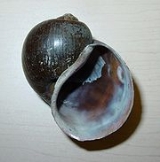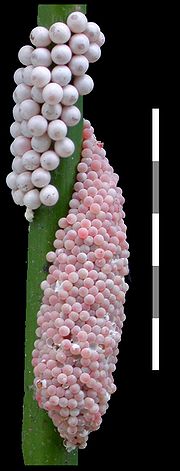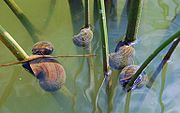
Pomacea insularum
Encyclopedia
Pomacea insularum, common name
the island applesnail, is a species
of freshwater snail
with an operculum
, an aquatic
gastropod mollusk in the family Ampullariidae, the applesnails.
 The shells
The shells
of these applesnails are globular in shape. Normal coloration typically includes bands of brown, black, and yellowish-tan. Color patterns are however extremely variable, and both albino and gold color variations exist.
The size of the shell is up to 150 mm in length.
and it probably occurs in Uruguay
and Paraguay
.
The type locality is the Río Paraná, which joins the Río Uruguay just above Buenos Aires
, forming the Río de la Plata
. The area between the Paraná and the Uruguay is the Argentine province of Entre Ríos
, the southern part of which is marshy, with channels connecting the Paraná and the Uruguay.
, Lake Brantley, and many other locations in Florida; Alabaha River
in Georgia; American Canal
and Mustang Bayou in Texas, and in 2006 in Verret Canal in Gretna, Louisiana. Established populations exist in Florida, Georgia, and Texas.
In Florida, Georgia, and Texas, initially the occurrences of Pomacea insularum were incorrectly identified as Pomacea canaliculata
. Subsequent genetic testing
confirmed that specimens collected in Florida, Georgia, and Texas were indeed Pomacea insularum.
In Taiwan
, where golden apple snails were introduced in Asia, Pomacea insularum maybe
misidentified as Pomacea canaliculata
.

 This snail lays pink eggs in clutches above the water level.
This snail lays pink eggs in clutches above the water level.
Common name
A common name of a taxon or organism is a name in general use within a community; it is often contrasted with the scientific name for the same organism...
the island applesnail, is a species
Species
In biology, a species is one of the basic units of biological classification and a taxonomic rank. A species is often defined as a group of organisms capable of interbreeding and producing fertile offspring. While in many cases this definition is adequate, more precise or differing measures are...
of freshwater snail
Snail
Snail is a common name applied to most of the members of the molluscan class Gastropoda that have coiled shells in the adult stage. When the word is used in its most general sense, it includes sea snails, land snails and freshwater snails. The word snail without any qualifier is however more often...
with an operculum
Operculum (gastropod)
The operculum, meaning little lid, is a corneous or calcareous anatomical structure which exists in many groups of sea snails and freshwater snails, and also in a few groups of land snails...
, an aquatic
Aquatic animal
An aquatic animal is an animal, either vertebrate or invertebrate, which lives in water for most or all of its life. It may breathe air or extract its oxygen from that dissolved in water through specialised organs called gills, or directly through its skin. Natural environments and the animals that...
gastropod mollusk in the family Ampullariidae, the applesnails.
Shell description

Gastropod shell
The gastropod shell is a shell which is part of the body of a gastropod or snail, one kind of mollusc. The gastropod shell is an external skeleton or exoskeleton, which serves not only for muscle attachment, but also for protection from predators and from mechanical damage...
of these applesnails are globular in shape. Normal coloration typically includes bands of brown, black, and yellowish-tan. Color patterns are however extremely variable, and both albino and gold color variations exist.
The size of the shell is up to 150 mm in length.
Distribution
The indigenous distribution of Pomacea insularum is South America. Pomacea insularum is reported from Argentina, Brazil, and BoliviaBolivia
Bolivia officially known as Plurinational State of Bolivia , is a landlocked country in central South America. It is the poorest country in South America...
and it probably occurs in Uruguay
Uruguay
Uruguay ,officially the Oriental Republic of Uruguay,sometimes the Eastern Republic of Uruguay; ) is a country in the southeastern part of South America. It is home to some 3.5 million people, of whom 1.8 million live in the capital Montevideo and its metropolitan area...
and Paraguay
Paraguay
Paraguay , officially the Republic of Paraguay , is a landlocked country in South America. It is bordered by Argentina to the south and southwest, Brazil to the east and northeast, and Bolivia to the northwest. Paraguay lies on both banks of the Paraguay River, which runs through the center of the...
.
The type locality is the Río Paraná, which joins the Río Uruguay just above Buenos Aires
Buenos Aires
Buenos Aires is the capital and largest city of Argentina, and the second-largest metropolitan area in South America, after São Paulo. It is located on the western shore of the estuary of the Río de la Plata, on the southeastern coast of the South American continent...
, forming the Río de la Plata
Río de la Plata
The Río de la Plata —sometimes rendered River Plate in British English and the Commonwealth, and occasionally rendered [La] Plata River in other English-speaking countries—is the river and estuary formed by the confluence of the Uruguay River and the Paraná River on the border between Argentina and...
. The area between the Paraná and the Uruguay is the Argentine province of Entre Ríos
Entre Ríos Province
Entre Ríos is a northeastern province of Argentina, located in the Mesopotamia region. It borders the provinces of Buenos Aires , Corrientes and Santa Fe , and Uruguay in the east....
, the southern part of which is marshy, with channels connecting the Paraná and the Uruguay.
Non-indigenous distribution
The initial introductions in the United States were probably from aquarium release, aka "aquarium dumping". The nonindigenous distribution includes the United States: Spring Hill Lake near Mobile, Alabama; Lake MunsonLake Munson
Lake Munson is a shallow impoundment on the southeast side of Tallahassee in Leon County, Florida.Historically known as Munson's Mill Pond as early as the 1840s, in 1950 a permanent dam was constructed...
, Lake Brantley, and many other locations in Florida; Alabaha River
Alabaha River
The Alabaha River is a tributary of the Satilla River in the U.S. state of Georgia. It forms in northwestern Pierce County at the junction of Hurricane Creek and Little Hurricane Creek and flows southeast, past the county seat of Blackshear, and joins the Satilla River at the Pierce...
in Georgia; American Canal
American Canal
The American Canal is an irrigation canal in the Upper Rio Grande Valley near El Paso, Texas. The canal acquires water from the Rio Grande from the American Diversion Dam at the Texas-New Mexico-Mexico border, 2 miles northwest of El Paso...
and Mustang Bayou in Texas, and in 2006 in Verret Canal in Gretna, Louisiana. Established populations exist in Florida, Georgia, and Texas.
In Florida, Georgia, and Texas, initially the occurrences of Pomacea insularum were incorrectly identified as Pomacea canaliculata
Pomacea canaliculata
Pomacea canaliculata, common name the channeled applesnail, is a species of large freshwater snail with gills and an operculum, an aquatic gastropod mollusk in the family Ampullariidae, the apple snails....
. Subsequent genetic testing
Genetic testing
Genetic testing is among the newest and most sophisticated of techniques used to test for genetic disorders which involves direct examination of the DNA molecule itself. Other genetic tests include biochemical tests for such gene products as enzymes and other proteins and for microscopic...
confirmed that specimens collected in Florida, Georgia, and Texas were indeed Pomacea insularum.
In Taiwan
Taiwan
Taiwan , also known, especially in the past, as Formosa , is the largest island of the same-named island group of East Asia in the western Pacific Ocean and located off the southeastern coast of mainland China. The island forms over 99% of the current territory of the Republic of China following...
, where golden apple snails were introduced in Asia, Pomacea insularum maybe
misidentified as Pomacea canaliculata
Pomacea canaliculata
Pomacea canaliculata, common name the channeled applesnail, is a species of large freshwater snail with gills and an operculum, an aquatic gastropod mollusk in the family Ampullariidae, the apple snails....
.
Ecology


Further reading
- Non-native applesnails in Florida - with map of distribution of Pomacea insularum in Florida.
- Applesnails of Florida on the UFUniversity of FloridaThe University of Florida is an American public land-grant, sea-grant, and space-grant research university located on a campus in Gainesville, Florida. The university traces its historical origins to 1853, and has operated continuously on its present Gainesville campus since September 1906...
/ IFASInstitute of Food and Agricultural SciencesThe University of Florida’s Institute of Food and Agricultural Sciences is a federal-state-county partnership dedicated to developing knowledge in agriculture, human and natural resources, and the life sciences, and enhancing and sustaining the quality of human life by making that information...
Featured Creatures Web site

